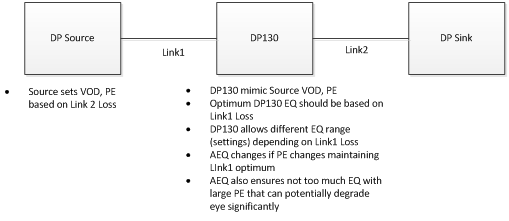Hi Team,
Could you please allow me to ask you about the equalizer function of SN75DP130.
[Question 1]
How does SN75DP130 optimize EQ gain setting through the link training sequence at default setting (automatic low-range EQ gain based on link training: DP mode) ?
I believe the Source and Sink will use AUX signal for link training. My understanding is that link training will only optimize pre-emphasis and VOD, by monitoring the AUX signal.
[Question 2]
In the table below, there are four EQ gain for "automatic xxxx-range EQ gain setting" (CAD_SNK=VIL, Link Training = ON).
What does AEQ "(L0)" / "(L1)" / "(L2)" / "(L3)" mean ? Does this number means that the device first applies higher gain and then sweeps to lower gain to find out the best gain setting out of this four settings ?
I also wonder why it is not the opposite like L0=0dB, L1=3.5dB....
Best Regards,
Kawai


